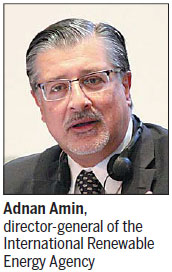Green power there for the grabbing
Updated: 2015-01-30 08:42
By Du Juan(China Daily Europe)
|
|||||||||||
Head of international energy agency says china must do more to help ensure there is a sustainable future
While China is the world's largest consumer of energy, it is also a leader in producing renewable energies with the potential to harness a diverse range of resources and technologies to cut down on its emissions, says the director-general of the International Renewable Energy Agency.
Adnan Amin, a Kenyan, says recently in Abu Dhabi that China must play a pivotal role in the global transition to a sustainable future.
According to a report by the agency, the share of renewables in China's energy mix will reach only 17 percent by 2030 compared with 13 percent in 2010 under current policies and investment patterns.
But the country could realistically increase renewables to 26 percent by 2030 if it invests about $145 billion by that time, according to the report.
"The investment could potentially save China more than $200 billion, factoring in the benefits of improved health and lower carbon emissions," says the report.
"China's energy use is expected to increase 60 percent by 2030. How China meets that need will determine whether or not the world can curb climate change," says Amin.

China has the biggest renewable energy power generation in the world, with an increasing number of solar photovoltaic and wind power plants. According to the nation's National Energy Administration, China's generation capacity for renewable energy in 2013 reached 360 million kilowatts; in 2014, it reached 430 million kW.
Over the next five years, Chinese companies plan to invest greatly in solar and wind power. Chinese authorities are encouraging more locally distributed solar power projects to ease the high costs of transmitting electricity over a long distance and to increase energy efficiency.
According to a 2014 energy development plan, China aims to add 14 million kW in new solar photovoltaic capacity, 60 percent of that produced are locally distributed projects.
According to latest data from the National Energy Administration, during the first three quarters of 2014, China added 3.79 million kW of new solar photovoltaic capacity, though that only accounted for 27 percent of the nation's annual target.
The administration did not provide details of the capacity generated by local projects, but in the last year, solar power generation soared 67 percent year-on-year to 26.52 million kilowatt hours.
Data from the China Electricity Council, a joint organization of China's power enterprises and institutions, show that China installed new wind power capacity of 6.09 million kilowatt in the first nine months last year, up 63 percent year-on-year.
"China should accelerate non-fossil energy projects including hydropower and nuclear," said the council in its seasonal report.
"China can continue its leadership in renewable energy by accelerating action in renewable area," says Amin. "If China acts now to implement more renewable energy, it can reduce air pollution, enhance energy security, create benefits for its economy, and play a leading role in fighting climate change."
Last year, China and the United States jointly announced moves to reduce emissions. The US said that in 15 years it would reduce emissions by 26 to 28 percent below 2005 levels. China said its carbon emissions will peak by 2030 and would make every effort to make this happen earlier.
Amin says it was perhaps "the most welcome news" of the year.
Globally, an energy system with substantial shares of renewables, specifically solar photovoltaic and wind power, would save significant amounts of water, thereby reducing strains on limited water resources, according to a report from the International Renewable Energy Agency.
"In addition to enhancing energy security, improving air quality, reducing carbon emissions and creating jobs, a greater deployment of existing renewable energy technologies can also bolster water and food security," Amin says.
The creation of jobs is an important piece to China's equation of growing green industries and could ultimately lead to a different chapter in the country's economic development.
According to International Renewable Energy Agency data, China was the largest global employer in 2013 in renewable energy industries, followed by Brazil, the United States, India, Germany, Spain and Bangladesh.
In 2013, the solar photovoltaic sector accounted for 2.3 million jobs globally that was largely concentrated in China. The nation has the most renewable energy generation installations in the world.
The Chinese solar photovoltaic industry employed 1.6 million people in 2013, according to data from the China National Renewable Energy Center, a government agency under the National Development and Reform Commission.
"This is a significant increase compared with the 2011 employment estimates of 300,000 to 500,000 jobs," says the report. "The trends show an increase in Chinese installation jobs, while manufacturing jobs remain stable as demand grows to absorb the oversupply in PV panels."
(China Daily European Weekly 01/30/2015 page16)
Today's Top News
China's port project in Greece not affected
Royal Mail Chairman Brydon to step down
Trial finds GSK Ebola shot safe, with immune response
Russian Delegation stripped of voting rights at PACE
China and Greece 'willing to continue cooperation'
China hails German leaders' call to remember history
Greece's new govt halts port sale to China
Putin sets government main task of ensuring social stability
Hot Topics
Lunar probe , China growth forecasts, Emission rules get tougher, China seen through 'colored lens', International board,
Editor's Picks

|

|

|

|

|

|





